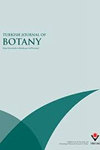
Turkish Journal Of Botany
期刊级别:SCI
- 国际刊号:1300-008X
- 国内刊号:--
- 期刊周期:--
- 主办单位:
 正刊通过真伪验证
正刊通过真伪验证 不成功全额退款
不成功全额退款
期刊介绍
SCIE期刊 学科领域:PLANT SCIENCES
The Turkish Journal of Botany is published electronically 6 times a year by the Scientific and Technological Research Council of Turkey (TÜBİTAK) and accepts manuscripts (in English) covering all areas of plant biology (including genetics, evolution, systematics, structure, function, development, diversity, conservation biology, biogeography, paleobotany, ontogeny, functional morphology, ecology, reproductive biology, and pollination biology), all levels of organisation (molecular to ecosystem), and all plant groups and allied organisms (algae, fungi, and lichens). Authors are required to frame their research questions and discuss their results in terms of major questions in plant biology. In general, papers that are too narrowly focused, purely descriptive, or broad surveys, or that contain only preliminary data or natural history, will not be considered (*).
The following types of article will be considered:
1. Research articles: Original research in various fields of botany will be evaluated as research articles.
2. Research notes: These include articles such as preliminary notes on a study or manuscripts on the morphological, anatomical, cytological, physiological, biochemical, and other properties of plant, algae, lichen and fungi species.
3. Reviews: Reviews of recent developments, improvements, discoveries, and ideas in various fields of botany.
4. Letters to the editor: These include opinions, comments relating to the publishing policy of the Turkish Journal of Botany, news, and suggestions. Letters should not exceed one journal page.
(*) 1. Raw floristic lists (of algae, lichens, fungi, or plants), species descriptions, chorological studies, and plant sociology studies without any additional independent approaches.
2. Comparative morphology and anatomy studies (that do not cover a family, tribe, subtribe, genus, subgenus, section, subsection, or species complexes with taxonomical problems) without one or more independent additional approaches such as phylogenetical, micromorphological, chromosomal and anatomical analyses.
3. Revisions of family, tribe, genus, subgenus, section, subsection, or species complexes without any original outputs such as taxonomical status changes, IUCN categories, and phenological and ecological analyses.
4. New taxa of all plants without any additional independent approaches such as phylogenetical, ecological, chromosomal, chorological and correlational analyses in addition to a detailed macro- and micro-morphological descriptions with quality field and microscopic illustrations of taxonomically important structures and identification key in the taxonomic group.
New records of all plants without any additional independent approaches such as phylogenetical, ecological, chromosomal, chorological and correlational analyses in addition to a detailed macro- and micro-morphological descriptions with quality field and microscopic illustrations of taxonomically important structures and identification key in the taxonomic group may be accepted for peer review if they contain 3 or more new records or taxonomical status update, such as lectotypification, new combinations, transfers, revivals and synonyms.
5. New taxa of algae, lichens, and fungi without any additional independent approaches such as phylogenetical, ecological, chromosomal, chorological and correlational analyses in addition to a detailed macro- and micro-morphological descriptions with quality field and microscopic illustrations of taxonomically important structures and identification key in the taxonomic group.
New records of algae, lichens, and fungi without any additional independent approaches such as phylogenetical, ecological, chromosomal, chorological and correlational analyses in addition to a detailed macro- and micro-morphological descriptions with quality field and microscopic illustrations of taxonomically important structures and identification key in the taxonomic group may be accepted for peer review if they contain 5 or more new records or taxonomical status update, such as lectotypification, new combinations, transfers, revivals and synonyms.
《土耳其植物学杂志》由土耳其科学技术研究理事会 (TÜBİTAK) 每年以电子版形式出版 6 期,接受涵盖植物生物学所有领域(包括遗传学、进化、系统学、结构、功能、发育、多样性、保护生物学、生物地理学、古植物学、个体发育、功能形态学、生态学、生殖生物学和授粉生物学)、所有组织层次(从分子到生态系统)以及所有植物群和相关生物(藻类、真菌和地衣)的稿件(英文稿件)。作者需要根据植物生物学的主要问题提出研究问题并讨论研究结果。一般来说,过于狭隘、纯描述性或广泛调查的论文,或仅包含初步数据或自然历史的论文将不予考虑 (*)。
将考虑以下类型的文章:
1.研究文章:植物学各个领域的原创研究将被评估为研究文章。
2. 研究笔记:这些包括研究的初步笔记或关于植物、藻类、地衣和真菌物种的形态学、解剖学、细胞学、生理学、生化和其他特性的手稿等文章。
3. 评论:对植物学各个领域的最新发展、改进、发现和想法的评论。
4. 致编辑的信:这些包括意见、与《土耳其植物学杂志》出版政策有关的评论、新闻和建议。信件不应超过一页期刊。
(*) 1. 原始植物区系列表(藻类、地衣、真菌或植物)、物种描述、地貌学研究和植物社会学研究,无需任何其他独立方法。
2.比较形态学和解剖学研究(不涵盖具有分类学问题的科、族、亚族、属、亚属、部分、亚部分或物种复合体),没有一个或多个独立的附加方法,例如系统发育、微形态、染色体和解剖学分析。
3. 对科、族、属、亚属、部分、亚部分或物种复合体的修订,没有任何原始成果,例如分类地位变化、IUCN 分类以及物候和生态分析。
4.所有植物的新分类群,无需任何额外的独立方法,如系统发育、生态、染色体、地域学和相关性分析,除了详细的宏观和微观形态描述,以及分类学上重要结构的高质量现场和微观插图和分类群中的识别关键字。
所有植物的新记录,如果包含 3 个或更多新记录或分类状态更新,如后选模式化、新组合、转移、复兴和同义词,则可以接受同行评审。
5.藻类、地衣和真菌的新分类群,无需任何额外的独立方法,例如系统发育、生态、染色体、地域学和相关性分析,除了详细的宏观和微观形态描述,以及分类学上重要结构的高质量现场和微观插图和分类群中的识别关键字。
藻类、地衣和真菌的新记录,如果包含 5 个或更多新记录或分类状态更新(例如后选模式化、新组合、转移、复兴和同义词),则可以接受同行评审。
该刊已被国际权威数据库SCIE收录,该刊致力于发表经过严格同行评审的高质量原创文章,反映PLANT SCIENCES领域的新进展、新技术、新成果,促进该领域科研交流和科研成果转化。该刊2023年影响因子为1.5,平均审稿速度为 较慢,6-12周 ,近四年来没有被列入预警名单。如果您需要投稿发表服务及指导,可以联系我们的客服老师,我们专业专注服务期刊投稿协助10年,为您提供期刊投稿个性化定制服务,并且我们确保严格保密您的个人信息及稿件内容。
CiteScore(2024年最新版)
由Elsevier提出,用来评估期刊学术影响力的指标
- CiteScore:2.9
- SJR:0.363
- SNIP:0.811
CiteScore 排名
| 学科 | 分区 | 排名 | 百分位 |
| 大类:Agricultural and Biological Sciences 小类:Plant Science | Q2 | 213 / 516 |
58% |
CiteScore:由Elsevier集团开发,类似影响因子用来评估杂志期刊学术影响力的一个指标。CiteScore采用了四年区间来计算每个期刊的学术引用。CiteScore拥有自带数据库Scopus,Scopus主要两个特点:一是免费面向所有人开放;二是采用透明的操作与计算,具有极高的可重复性。
由中国科学院国家科学图书馆制定出来的分区
2023年12月升级版
| 大类学科 | 分区 | 小类学科 | 分区 | Top期刊 | 综述期刊 |
| 生物学 | 4区 | PLANT SCIENCES 植物科学 | 4区 | 否 | 否 |
2022年12月升级版
| 大类学科 | 分区 | 小类学科 | 分区 | Top期刊 | 综述期刊 |
| 生物学 | 4区 | PLANT SCIENCES 植物科学 | 4区 | 否 | 否 |
2021年12月旧的升级版
| 大类学科 | 分区 | 小类学科 | 分区 | Top期刊 | 综述期刊 |
| 生物学 | 4区 | PLANT SCIENCES 植物科学 | 4区 | 否 | 否 |
2021年12月基础版
| 大类学科 | 分区 | 小类学科 | 分区 | Top期刊 | 综述期刊 |
| 生物 | 4区 | PLANT SCIENCES 植物科学 | 4区 | 否 | 否 |
2021年12月升级版
| 大类学科 | 分区 | 小类学科 | 分区 | Top期刊 | 综述期刊 |
| 生物学 | 4区 | PLANT SCIENCES 植物科学 | 4区 | 否 | 否 |
2020年12月旧的升级版
| 大类学科 | 分区 | 小类学科 | 分区 | Top期刊 | 综述期刊 |
| 生物学 | 4区 | PLANT SCIENCES 植物科学 | 4区 | 否 | 否 |
基础版:将SCI期刊分为数学、物理、化学、医学、环境科学与生态学、生物、农林科学、工程技术、地学、地学天文、社会科学、管理科学及综合性期刊13个大类学科,再根据各大类期刊3年的平均影响因子进行划分。前5%为该类1区、6%~20% 为2区、21%~50%为3区,最后50%为4区,由高到低呈现金字塔状。
升级版:收录期刊涵盖了自然科学期刊(SCIE)、社会科学期刊(SSCI)和ESCI收录的中国期刊(自科+社科)(不包含A&HCI期刊和ESCI国外期刊)。从2022年起将只发布升级版。升级版涵盖254个小类的18个大类。为了更好描述期刊的主题表现,升级版设计了“期刊超越指数”取代影响因子指标。期刊超越指数,即本刊论文的被引频次高于相同主题、相同文献类型的其它期刊的概率。
JCR分区(2023-2024年最新版)
由科睿唯安公司(原为汤森路透)制定
| 按JIF指标学科分区 | 收录子集 | 分区 | 排名 | 百分位 |
| 学科:PLANT SCIENCES | SCIE | Q3 | 148 / 265 |
44.3% |
| 按JCI指标学科分区 | 收录子集 | 分区 | 排名 | 百分位 |
| 学科:PLANT SCIENCES | SCIE | Q3 | 158 / 265 |
40.57% |
JCR分区是由科睿唯安公司(原汤森路透,2016年易主科睿唯安)每年发布的,设置了254个具体学科,根据每个学科分类按照期刊当年的影响因子高低将期刊平均分为4个区,分别为Q1、Q2、Q3和Q4,各占25%。JCR分区包括自然科学(Science Edition)和社会科学(Social Sciences Edition)两个版本。其中,JCR-Science涵盖来自83个国家或地区、约2000家出版机构的8500多种期刊,覆盖176个学科领域。JCR-Social Sciences涵盖来自52个国家或地区、713家出版机构3000多种期刊,覆盖56个学科领域。
期刊推荐

- Food Security
- 期刊级别:SCI
- 主办单位:
- 周期: --
- 国际刊号:1876-4517
- 国内刊号:--


- International Journal Of Oral Science
- 期刊级别:SCI
- 主办单位:
- 周期: --
- 国际刊号:1674-2818
- 国内刊号:--


- Clinical Microbiology Reviews
- 期刊级别:SCI
- 主办单位:UNITED STATES
- 周期: --
- 国际刊号:0893-8512
- 国内刊号:--


- International Journal Of Geographical Information Science
- 期刊级别:SCI
- 主办单位:
- 周期: --
- 国际刊号:1365-8816
- 国内刊号:--




